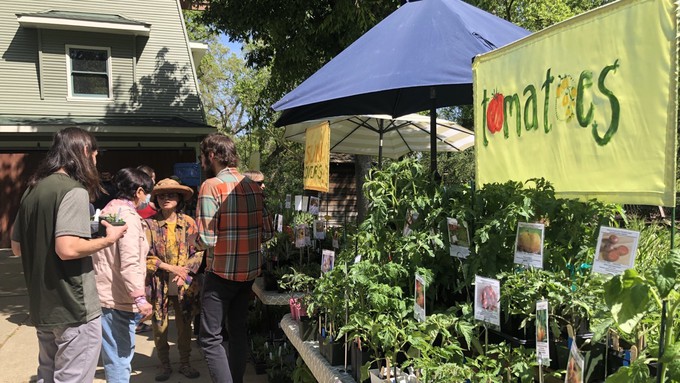
April puts spotlight on America's growing pastime

Gardeners love to find new plants. Sacramento perennials expert Daisy Mah, in hat, talks to shoppers at the Perennial Plant Club's plant sale Friday morning in South Natomas. The sale continues Saturday from 9 a.m. to 1 p.m., 1911 Bannon Creek Drive. Kathy Morrison
Happy National Gardening Day! If you want to celebrate, just go outside.
Never heard of this proclaimed commemoration of our favorite pastime? As special days go, it’s not that old – the Registrar of the National Day Calendar recognized it in 2018. But with renewed interest in gardening, it’s all over social media on Friday with lots of suggestions on what to do.
“U.S. National Gardening Day on April 14 is a day of encouragement, a day created to give gardeners a shove and a shovel so that they can begin their gardening journey,” say its creators.
At its roots, National Gardening Day was invented to sell books. Cool Springs Press, a major publisher of gardening books, gets credit for the idea. Its online catalog lists more than 500 gardening and home improvement titles including the ever-popular “Square Foot Gardening” by Mel Bartholomew.
Gardening is America's No. 1 hobby with more than 55% of all households considered "active gardeners." And that group is growing; in a recent survey, two out of three American households plan to grow food plants this year.
April 14 falls near the middle of National Gardening Month, which traces back to 1986. Then-President Ronald Reagan declared the second week of April as National Gardening Week after lobbying by the National Garden Bureau, which had banded together about two dozen horticultural groups to support the measure.
“All gardeners know the innumerable benefits that gardening brings to people and their communities, and this is a month where we can spread that message to those who aren’t directly involved,” Reagan said in the original proclamation. “All around the country, educational activities, public events, government proclamations, local plant sales and swaps, and garden center seminars, are all occurring this month, building excitement and increasing participation in gardening.”
Started in 1920, the National Garden Bureau is a non-profit organization best known for championing Victory Gardens during World War II. It’s evolved into the nursery industry’s main marketing arm, connecting horticultural experts with gardeners nationwide.
In 2002, National Gardening Week stretched into National Gardening Month, which was pushed by the National Gardening Association.
Now, the National Gardening Association declares every April as its month. The association boasts more than 1 million online members and an in-depth website, https://garden.org/. Its plant database for example includes more than 750,000 plant photos.
National Gardening Month is a natural. For nurseries, April is like Christmas – their busiest time of the year. Garden clubs nationwide use April for new member recruitment and spring activities. And everybody is celebrating National Gardening Day.
So, how should you commemorate this day dedicated to getting hands dirty? Here’s the advice from the National Gardening Day organizers:
“As many gardeners know, the benefits of gardening come from more than the produce. Spending time in the garden also provides physical activity and an opportunity to join with nature. The day is a call to action to get out and grow flower or vegetable gardens. No matter how you garden, plant in the ground, in containers, in straw bales or in a square foot gardening box. Just garden!”
Adds the National Garden Bureau, “Above all, have fun! When you garden, you grow!”
For more inspiration from the National Garden Bureau: https://ngb.org/.
Comments
0 comments have been posted.Sacramento Digs Gardening to your inbox.
Sites We Like
Garden Checklist for week of July 21
Your garden needs you!
* Keep your vegetable garden watered, mulched and weeded. Water before 8 a.m. to reduce the chance of fungal infection and to conserve moisture.
* Feed vegetable plants bone meal, rock phosphate or other fertilizers high in phosphate to stimulate more blooms and fruiting. (But wait until daily high temperatures drop out of the 100s.)
* Don’t let tomatoes wilt or dry out completely. Give tomatoes a deep watering two to three times a week.
* Harvest vegetables promptly to encourage plants to produce more. Squash especially tends to grow rapidly in hot weather. Keep an eye on zucchini.
* Pinch back chrysanthemums for bushy plants and more flowers in September.
* Remove spent flowers from roses, daylilies and other bloomers as they finish flowering.
* Pinch off blooms from basil so the plant will grow more leaves.
* Cut back lavender after flowering to promote a second bloom.
* It's not too late to add a splash of color. Plant petunias, snapdragons, zinnias and marigolds.
* From seed, plant corn, pumpkins, radishes, winter squash and sunflowers.